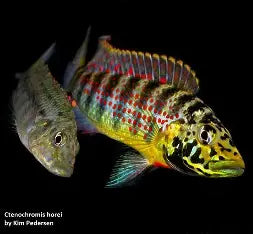Lake Tanganyika Cichlids
Lake Tanganyika is home to some of the most distinctive types of cichlid fish found worldwide. These cichlids include some of the most expensive freshwater fish available on the market. African cichlids from this region display an impressive variety of body shapes, behaviors, and colors. Aquarium enthusiasts searching for cichlids from Lake Tanganyida often value their exceptional uniqueness.
While Lake Malawi is famous for colorful cichlids, Lake Tanganyika offers a much greater diversity of cichlid species. African cichlids from Lake Tanganyika are recognized for their high variance in appearance and fascinating social behaviors. In fact, the extraordinary diversity among these cichlids surpasses typical variation seen in other fish families. Many hobbyists seek out rare african cichlids for sale from this remarkable ecosystem.
These cichlids are active and display complex social behavior. Given the right environment, many species can be successfully bred in captivity. Popular types include Tropheus Cichlids, Frontosa, Goby Cichlids, Sardine Cichlids, shell-dwellers, featherfins, and sand-sifters. They are admired not only for their striking looks, but also for their unique body shape and engaging demeanor. Keeping these fish provides aquarists an outstanding and rewarding experience in their cichlid tank.
The Diversity of Lake Tanganyika
The favored Tropheus genus is a prime example of this diversity. Tropheus cichlids are found all across the lake. Even within this group, several subgroups exist due to microgeographic specialization. Tropheus are rock-dwelling fish, much like the Mbuna from Lake Malawi. However, each group prefers to stay within three feet of its chosen rock island home. Across Lake Tanganyika, different Tropheus groups remain isolated, forming many varieties, each with its own color pattern.
Goby Cichlids from Lake Tanganyika are especially interesting and attractive. They differ both in their natural habitats and their body shapes. These small fish, which usually grow to about 3 inches, are typically found near the shore in shallow water. Currently, scientists recognize five species among three genera in this group. Each adds a unique flair to any african cichlid tank.
The Frontosa, or C. Frontosa, is another beloved species in the world of African cichlids for sale. There are other fascinating body forms and behavioral types among this group, including Sardine Cichlids, featherfins, shell-dwellers, and sand-dwelling cichlids. For aquarists wanting the most unusual species, the cichlids from Lake Tanganyika stand out as unparalleled options.
Lake Tanganyika Habitats
Lake Tanganyika, one of Africa's great rift lakes, formed millions of years ago due to tectonic plate movement. Along with its sister lake, Lake Malawi, it is among the world's oldest and deepest freshwater lakes. A number of smaller lakes and ponds also formed nearby. Lake Tanganyika's great depth, reaching 4,823 feet, helps sustain stable, oxygen-rich waters perfect for diverse aquatic life.
About 250 different species of cichlids from Lake Tanganyika have been identified, along with more than 150 other fish species. These cichlids can inhabit rocky areas, sandy areas, midwater zones, or even a mix of all three habitats. Keeping these species provides a glimpse into these diverse and fascinating aquatic ecosystems.
Other Species of Tanganyikans
Lake Tanganyika is home to a wide range of unique cichlid species. These include Sardine cichlids, Julie Cichlids, featherfins, shell-dwellers, and sand cichlids. Each group displays distinct body forms and behaviors. Exploring additional options can enhance your aquarium setup with a diverse collection of African cichlids for sale.
Aquarium Setup
The size of your aquarium should match the species and quantity of cichlids you want to keep. Many smaller species can thrive as pairs in a 10-gallon tank and as a group in a 20-gallon tank. For a cichlid community, 55 gallons or more is best. Larger species need even more space to thrive in a healthy cichlid tank.
Tanganyikans are naturally aggressive. In the limited space of an aquarium, aggression may increase, especially if space is too small or there are not enough hiding places. Careful planning of your aquarium setup helps prevent predation, aggressive incompatibility, and even undesirable hybridization.
Decide in advance which types of cichlids you want to keep, and choose a tank size and decor to match. Different Tanganyika species can live together as long as each receives its proper habitat. For example, Sardine Cichlids need open areas in the upper tank, while Tropheus require rocks and caves. Goby Cichlids need holes near the bottom. Well-planned aquascaping will make Tanganyika cichlids feel at home.
Diet
Feed your fish a balanced diet. Frozen or live brine shrimp, mysis, high-quality flake food, pellets, and spirulina are good choices. Use specialty foods designed for omnivorous cichlids. Offer small meals several times a day rather than one large serving to keep your cichlid fish healthy.




